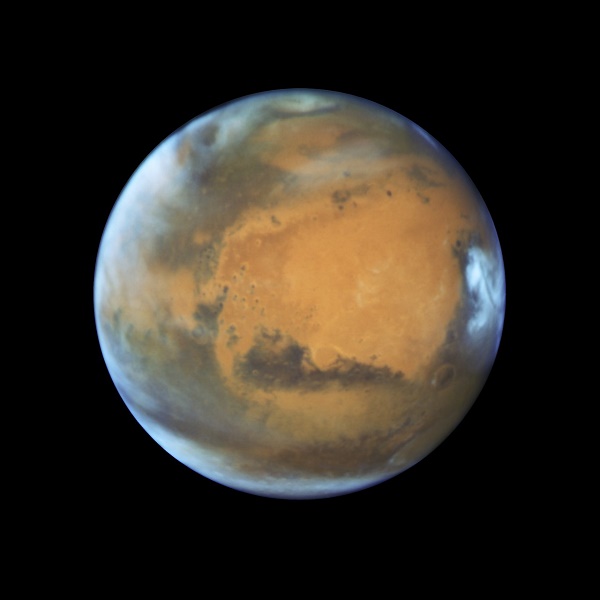Hubble Captures Biggest, Brightest View of Mars
| Ana Verayo | | May 21, 2016 04:46 AM EDT |
(Photo : NASA, ESA, the Hubble Heritage Team (STScI/AURA), J. Bell (ASU), and M. Wolff (Space Science Institute)) This image shows our neighbouring planet Mars, as it was observed shortly before opposition in 2016 by the NASA/ESA Hubble Space Telescope.
The European Space Agency and NASA's Hubble Space Telescope recently captured an awe inspiring image of Mars revealing its clouds and craters including its polar ice caps.
This new photo was taken on May 12, where Mars was just at a relatively close distance of 50 million miles from the Earth. This means that Mars is almost transitioning to its opposition phase, when the sun and the Earth is directly in between of the Red Planet, come May 22, Sunday.
Like Us on Facebook
According to European Space Agency officials, this Mars opposition is also a cosmic event when the Red Planet is at its nearest point to Earth during its orbit, which would mean that Mars is also observed to be bigger and brighter in the sky than normal.
Astronomers take advantage of this event by using space telescopes and ground observatories to capture more details and features on the surface of Mars. The actual dates of the closest approach of Mars and Earth and their opposition do not need to match exactly.
This year's closest approach will occur on May 30 where Mars and Earth will be only separated by 46.8 million miles from each other. Martian oppositions usually occur at an average period of 780 days where the last time that the sun, the Earth and Mars are all lined up in their orbits was April 2014. However, there are still more closer approaches than the others, where Mars was at the closest to Earth in 2003 at a distance of 34.65 million miles, where astronomers say that this has been the closest point between Earth and Mars in 60,000 years.
In this new image captured by Hubble, taken by its Wide Field Camera 3 instrument, Mars is shown in a natural color view, where many of its geological features are visible, such as mountains, canyons, plains and craters.
ESA officials say that the orange region in the equatorial region is known as Arabia Terra which is a vast upland area. This unique landscape is seen to be heavily cratered from ancient impacts where erosion and weathering are evident, suggesting that these might be the oldest features of the dusty world.
The Arabia Terra spans across the eastern to the western regions of the equator where long, dark features are seen on its south, known as Sinus Sabaeus in the east and Sinus Meridiani in the west. These are caused by ancient lava flows forming this dark bedrock across the equatorial region along with other volcanic features.
There are clouds that seem to form a blanket across these dark volcanic plains of Syrtis Major. On the right face of Mars there is also a sprawling ice cap in the southern polar region compared to the smaller northern polar region since it is summer season on Mars.
The Hubble Space Telescope was launched in 1990 which was placed into orbit by NASA's space shuttle Discovery. In 1993, astronauts repaired its mirror during a spacewalk which has been making tremendous scientific discoveries ever since. NASA officials say that Hubble will still be operating until at least 2020.
TagsHubble Space Telescope, hubbe, Mars, hubble mars, image mars hubble
©2015 Chinatopix All rights reserved. Do not reproduce without permission
EDITOR'S PICKS
-

Did the Trump administration just announce plans for a trade war with ‘hostile’ China and Russia?
-

US Senate passes Taiwan travel bill slammed by China
-

As Yan Sihong’s family grieves, here are other Chinese students who went missing abroad. Some have never been found
-

Beijing blasts Western critics who ‘smear China’ with the term sharp power
-

China Envoy Seeks to Defuse Tensions With U.S. as a Trade War Brews
-

Singapore's Deputy PM Provides Bitcoin Vote of Confidence Amid China's Blanket Bans
-

China warns investors over risks in overseas virtual currency trading
-

Chinese government most trustworthy: survey
-

Kashima Antlers On Course For Back-To-Back Titles
MOST POPULAR
LATEST NEWS
Zhou Yongkang: China's Former Security Chief Sentenced to Life in Prison

China's former Chief of the Ministry of Public Security, Zhou Yongkang, has been given a life sentence after he was found guilty of abusing his office, bribery and deliberately ... Full Article
TRENDING STORY

China Pork Prices Expected to Stabilize As The Supplies Recover

Elephone P9000 Smartphone is now on Sale on Amazon India

There's a Big Chance Cliffhangers Won't Still Be Resolved When Grey's Anatomy Season 13 Returns

Supreme Court Ruled on Samsung vs Apple Dispute for Patent Infringement

Microsoft Surface Pro 5 Rumors and Release Date: What is the Latest?










